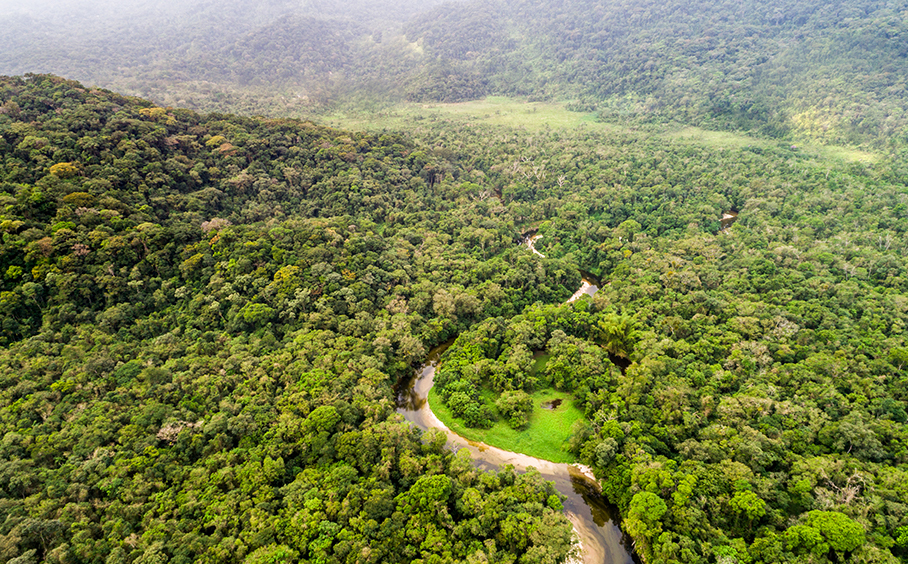
Photo by gustavofrazao via iStock
Issue
Deforestation leads to a decrease in the water and soil conservation functions and a greater risk of flooding
Solution
Local people themselves learned forest management techniques to contribute to the restoration of forests and create livelihood opportunities
Forest in Nicaragua at Risk
In the León Province of Nicaragua, farming and grazing were practiced from the plains to the mountains, and local people made their living from these activities. However, these land-use practices were causing serious degradation of the forest, and its function to conserve water and soil was declining. The forest had reduced rapidly due to deforestation and uncontrolled cultivation by traditional slash-and-burn farming. In addition, the rapid rise of rivers during the rainy season, the lack of water during the dry season, and the collapse of sloping land were also issues facing the region. However, the Forestry Agency and other related organizations lacked the knowledge and experience to effectively implement water and soil conservation activities with local participation and did not have the know-how to do so in an organized manner. Therefore, a project was devised to enhance the water and soil conservation functions of forests under local initiatives of local people, with the goal of contributing to the improvement of their lives.
Sustainable Forest Management Led by Local Community
Against this background, the promotion of sustainable forest management activities by participants was implemented with Japanese support in nine villages from 2006 to 2011. The project aimed to improve forest management and soil and water conservation in the target villages through the preparation of disaster prevention forest management plans. It assisted the establishment of a support system for participatory forest management by the government for the communities, and the implementation of training on participatory forest management for the Forestry Agency and municipal officials, as well as training on forest management and soil and water conservation for people in the target villages.

Photo by FG Trade via iStock
Under these activities, the project has succeeded in restoring the water and soil conservation functions of the watershed through forest management and afforestation projects, and in implementing disaster risk reduction based on these activities through forest management by local people. In addition to disaster prevention, the forest conservation activities in this project have brought a wide range of benefits to the community, including carbon fixation, water storage, and purification, economic revitalization of the local peoples, biodiversity conservation, and environmental education.
Education is a Key Success Factor
People who participated in the project learned forest management techniques such as natural forest management and afforestation by learning and working on their own. One of the characteristics of this project was that it did not focus on regulations or crackdowns for forest conservation, but rather on educating the people through workshops and other activities, and on providing guidance to obtain their participation and cooperation. Of the households that participated in the activities, 79% developed and implemented their own action plans for forest management activities such as coffee cultivation, soil conservation, wildfire prevention, and home gardens.
In addition, as part of environmental education, workshops and visits by extension agents have been conducted in the target villages to raise awareness of the significance of soil conservation and forest management. In elementary schools in the target villages, environmental education has been conducted for children through school activities such as poster-making on the theme of environmental conservation, a contest, forest observation, and village beautification activities. As a result, there has been a significant decrease in the number of uncontrolled fires on farmland, which can be taken as a result of the implementation of environmental improvement activities through environmental education. Thus, one of the success factors of this activity would have been raising the awareness of local people so that they can recognize the benefits from cultivating forests, i.e., the various benefits that ecosystems bring in normal times.
Forest for Better Livelihoods
In addition to forestation and enhancement of forest management, the project also promoted the introduction of agroforestry and silvopastoral, in which trees are planted in some of the existing agricultural and pastoral areas, and livestock and crops are raised and cultivated among the trees. It is noteworthy that the project also took into account the economic activities of local people, such as planting useful tree species for firewood and coffee crops. As a result, agricultural productivity, including coffee cultivation, has increased in the villages where forest management activities have been implemented. Such participatory forest management activities are reflected in the Nicaraguan government's "Forestería Comunitaria" (Community Forest) strategy and disseminated to other parts of Nicaragua as an effective model.




